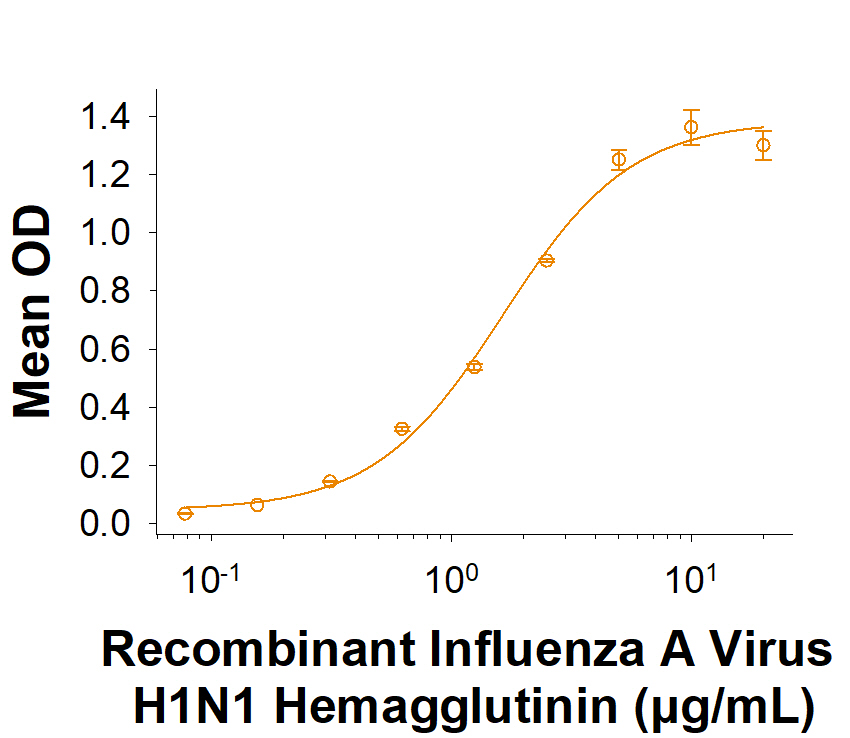Recombinant Influenza A Virus H1N1 Hemagglutinin Protein, CF
Recombinant Influenza A Virus H1N1 Hemagglutinin Protein, CF Summary
Product Specifications
Asp18-Gln529, with a C-terminal 6-His tag
Analysis
Product Datasheets
Carrier Free
CF stands for Carrier Free (CF). We typically add Bovine Serum Albumin (BSA) as a carrier protein to our recombinant proteins. Adding a carrier protein enhances protein stability, increases shelf-life, and allows the recombinant protein to be stored at a more dilute concentration. The carrier free version does not contain BSA.
In general, we advise purchasing the recombinant protein with BSA for use in cell or tissue culture, or as an ELISA standard. In contrast, the carrier free protein is recommended for applications, in which the presence of BSA could interfere.
11202-HA
| Formulation | Supplied as a 0.2 μm filtered solution in PBS with Trehalose. |
| Shipping | The product is shipped with dry ice or equivalent. Upon receipt, store it immediately at the temperature recommended below. |
| Stability & Storage: | Use a manual defrost freezer and avoid repeated freeze-thaw cycles.
|
Scientific Data
 View Larger
View Larger
Measured by its binding ability in a functional ELISA. When Recombinant Human Galectin-1 (1152-GA) immobilized at 10.00 μg/mL, 100 μL/well, the concentration of Recombinant Influenza A Virus H1N1 Hemagglutinin His-tag Protein (Catalog # 11202-HA) that produces 50% of the binding response is 0.500-5.00 μg/mL.
 View Larger
View Larger
2 μg/lane of Recombinant Influenza A Virus H1N1 Hemagglutinin Protein (Catalog # 11202-HA) was resolved with SDS-PAGE under reducing (R) and non-reducing (NR) conditions and visualized by Coomassie® Blue staining, showing bands at 55-70 kDa.
Reconstitution Calculator
Background: Hemagglutinin
Hemagglutinin (HA) and neuraminidase (NA) are major membrane glycoproteins found on the surface of influenza virus. The two proteins are essential for the infectious cycle of the influenza virus. During initial infection, HA binds to sialic acid-containing receptors on the cell surface, bringing about the attachment of the virus particle to the cell. HA exists as a homotrimer, with each monomer composed of a globular HA1 domain and the stalk-like HA2 domain. HA has evolved to recognize long alpha 2-6 sialylated glycans for efficient transmission in human population. Although the HA sequence patterns of the 1918 pandemic and 2009 pandemic viruses are similar, they were caused by different H1N1 subtype viruses. The H1N1 1918 HA shares 86% amino acid sequence identity with the H1N1 2009 HA. Inhibiting HA-mediated membrane fusion is a target for influenza therapies. The HA section in the 1918 virus is being currently used to investigate how the 1918 pandemic spread and how a modern pandemic influenza virus would play out in the future.
- Michal Lazniewski, M. et al. (2018) Briefings in Functional Genomics 17:415.
- Sriwilaijaroen, N. and Suzuki, Y. (2012) Proc Jpn Acad Ser B Phys Biol Sci. 88:226.
- Chang, Y.J. et al. (2021) Sci Rep 11:8637.
- Short, K. et al. (2018) Front. Cell. Infect. Microbiol. 8:343.
FAQs
No product specific FAQs exist for this product, however you may
View all Proteins and Enzyme FAQsReviews for Recombinant Influenza A Virus H1N1 Hemagglutinin Protein, CF
There are currently no reviews for this product. Be the first to review Recombinant Influenza A Virus H1N1 Hemagglutinin Protein, CF and earn rewards!
Have you used Recombinant Influenza A Virus H1N1 Hemagglutinin Protein, CF?
Submit a review and receive an Amazon gift card.
$25/€18/£15/$25CAN/¥75 Yuan/¥1250 Yen for a review with an image
$10/€7/£6/$10 CAD/¥70 Yuan/¥1110 Yen for a review without an image
